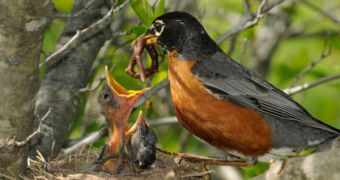Humans, as a race, have lost the ability to tell apart the subtle differences in the length of the day when winter turns into spring. Despite the fact that each day is several minutes longer than the previous one, we no longer can tell the difference, except by looking at watches and calendars. But researchers have known for a long time that birds are perfectly able to realize the differences, and have been dying to know how this happens. A new study has recently revealed that a specific protein is responsible for his ability that the winged creatures have, ScienceNow informs.
Knowing exactly what time of the year it is has over millions of years of evolution become of paramount importance for bird species. While some need to breed earlier on in the year, so as to ensure that they have moist soil to search for worms to feed their offspring, other need to wait a few months longer so that they have the seeds they are accustomed to. Any mistakes in calculating the correct time, and the next generation could starve to death, which would threaten if not the entire species, than at least the local population.
“It's the increasing day length in early spring that triggers all these reproductive responses,” explains the lead author of the new study, University of Oxford neuroscientist Russell Foster. In the 1930s, early studies demonstrated that it was not the eyes of the birds that were responsible for their ability to perceive seasonal change, but a part of the brain called the hypothalamus. When artificially illuminated with light lasting as much as it does in a spring day, the birds showed signs specific to the breeding season, whereas, when exposed to winter day amounts of lights, no changes were detected.
This makes sense, Foster says, because the skull of birds is so thin, and their brain so small that light is able to penetrate deeply, as far as the hypothalamus. And the light sensors are “close to all those bits in the hypothalamus that are regulating the reproductive system,” he adds. For many years, the exact location of the light sensors was unknown, but a breakthrough came in 1997, when Foster's team discovered the vertebrate ancient opsin (VA opsin) protein, in the eyes of salmon.
“We thought, 'Great! This is going to be the brain photoreceptor of birds and reptiles and amphibians and fish',” Foster states, but another decade-worth of work found no signs of VA opsin in birds. In their studies of chicken, the scientists in the UK sequenced the genome of chicken, and found an area located on chromosome 6 that exhibited 70 percent similarity to the same part of chromosome 6 on zebrafish. The protein coded here was expressed in chicken eyes and brain tissue.
In their study, published in the latest issue of the journal Current Biology, the team reveals how it started engineering mouse nerve cells to produce the gene's protein. Their investigation was successful. The protein immediately became photosensitive, and generated electrical impulses when exposed to light. When they created antibodies for the VA opsin, they moved directly to the hypothalamus, which also revealed the protein's location. “[That's] exactly the region of the brain where all of the early studies had suggested there had to be a photoreceptor,” Foster concludes.

 14 DAY TRIAL //
14 DAY TRIAL //